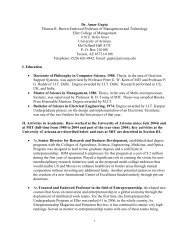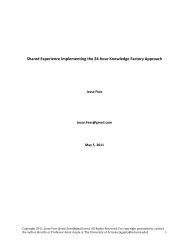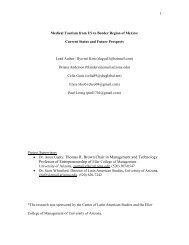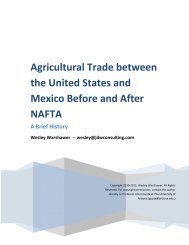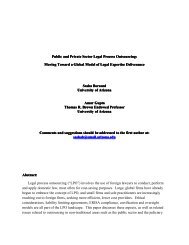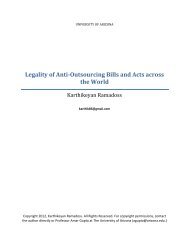Offshoring in the Flower Retail Industry - University of Arizona
Offshoring in the Flower Retail Industry - University of Arizona
Offshoring in the Flower Retail Industry - University of Arizona
You also want an ePaper? Increase the reach of your titles
YUMPU automatically turns print PDFs into web optimized ePapers that Google loves.
Runn<strong>in</strong>g Head: OFFSHORING IN THE FLOWER RETAIL INDUSTRY 1<br />
<strong>Offshor<strong>in</strong>g</strong> <strong>in</strong> <strong>the</strong> <strong>Flower</strong> <strong>Retail</strong> <strong>Industry</strong>: Us<strong>in</strong>g <strong>the</strong> 24 Hour<br />
Knowledge Factory to Create a Global <strong>Flower</strong> Shop<br />
Maria Klucarova<br />
<strong>University</strong> <strong>of</strong> <strong>Arizona</strong><br />
klucarom@email.arizona.edu<br />
Copyright 2011, Maria Klucarova. All Rights Reserved. For copyright permissions, contact <strong>the</strong> author<br />
directly or Pr<strong>of</strong>essor Amar Gupta at The <strong>University</strong> <strong>of</strong> <strong>Arizona</strong> (agupta@arizona.edu.)
OFFSHORING IN THE FLOWER RETAIL INDUSTRY 2<br />
Abstract<br />
In today’s busy society, a consumer is look<strong>in</strong>g for quick, convenient and reliable services.<br />
The purchases onl<strong>in</strong>e are grow<strong>in</strong>g rapidly; one can place an order for almost anyth<strong>in</strong>g at anytime<br />
via <strong>the</strong> <strong>in</strong>ternet. This paper will exam<strong>in</strong>e <strong>the</strong> 24-Hour Knowledge Factory to <strong>of</strong>fshore <strong>the</strong><br />
American flower retail <strong>in</strong>dustry to India, Bulgaria and <strong>the</strong> U.S. The goal <strong>of</strong> <strong>the</strong> “24-Hour <strong>Flower</strong><br />
Shop” is to utilize <strong>the</strong> 24-Hour Knowledge Factory Model, which will allow <strong>the</strong> job to be<br />
performed on a “round <strong>the</strong> clock basis.” By do<strong>in</strong>g so, <strong>the</strong> employees <strong>in</strong> <strong>the</strong> U.S., India and<br />
Bulgaria will work dur<strong>in</strong>g <strong>the</strong> daytime, regular n<strong>in</strong>e hour shifts. When <strong>the</strong>y f<strong>in</strong>ish, all <strong>the</strong><br />
activities will be transferred to a team <strong>in</strong> ano<strong>the</strong>r country. By us<strong>in</strong>g <strong>the</strong> 24-Hour Knowledge<br />
Factory model, <strong>the</strong> night shifts will be elim<strong>in</strong>ated and services will be provided from different<br />
countries at all times. The orders can be placed from anywhere <strong>in</strong> <strong>the</strong> world and delivered to<br />
customers <strong>in</strong> <strong>the</strong> U.S., South America, Asia, Europe, Africa and Australia. The website will<br />
provide an 800-number but; most importantly <strong>the</strong> l<strong>in</strong>k which will directly connect a customer to<br />
a representative <strong>in</strong> ei<strong>the</strong>r one <strong>of</strong> <strong>the</strong> centers. The face-to-face contact will be available through<br />
Skype services or <strong>the</strong> Cisco product “TelePresence”. In conclusion, this paper will address <strong>the</strong><br />
need for more person-to-person <strong>in</strong>teraction with <strong>the</strong> goal <strong>of</strong> provid<strong>in</strong>g <strong>the</strong> best and fastest<br />
services with knowledgeable, skilled and culturally aware teams <strong>of</strong> representatives <strong>in</strong> all centers.<br />
Us<strong>in</strong>g that approach, <strong>the</strong> goal is to satisfy <strong>the</strong> <strong>in</strong>creas<strong>in</strong>g demand for flower orders onl<strong>in</strong>e, and<br />
encourage person-to-person <strong>in</strong>teraction ra<strong>the</strong>r than automated answer<strong>in</strong>g systems.
OFFSHORING IN THE FLOWER RETAIL INDUSTRY 3<br />
I. Introduction<br />
Floriculture is a huge multi-billion dollar <strong>in</strong>dustry and obta<strong>in</strong>s a significant part <strong>in</strong><br />
economies <strong>of</strong> many countries around <strong>the</strong> world. As <strong>of</strong> <strong>the</strong> sales, 2006 has been reported as <strong>the</strong><br />
best year ever with $2.34 billion <strong>in</strong> sales for grow<strong>in</strong>g greenhouse products but <strong>the</strong>re is also<br />
reported $1.52 billion <strong>in</strong> sales (majority is wholesale and public) for flowers and plants<br />
(“Statistical Agency <strong>of</strong> Canada”). The flower <strong>in</strong>dustry is comprised <strong>of</strong> greenhouses with cut<br />
flowers <strong>in</strong> Israel to numerous amenities that focus on bedd<strong>in</strong>g plants <strong>in</strong> California (Sacramento<br />
Valley). Floriculture is a part <strong>of</strong> horticulture that concentrates on cultivation <strong>of</strong> ornamental<br />
plants, specifically flower<strong>in</strong>g plants. The major floriculture crops are cut flowers, herbaceous<br />
perennials, potted flower<strong>in</strong>g plants, foliage plants and bedd<strong>in</strong>g plants. In addition to that, <strong>the</strong><br />
flower <strong>in</strong>dustry also controls pests that harm and destroy ornamental crops.<br />
History <strong>of</strong> Floriculture<br />
The cultivation <strong>of</strong> flower<strong>in</strong>g plants has been around for hundreds <strong>of</strong> years for <strong>the</strong> purpose<br />
<strong>of</strong> decorat<strong>in</strong>g houses, <strong>of</strong>fices, express<strong>in</strong>g one’s feel<strong>in</strong>gs; but also for use <strong>in</strong> religious ceremonies<br />
and <strong>in</strong> medic<strong>in</strong>e. Whe<strong>the</strong>r it is music, pa<strong>in</strong>t<strong>in</strong>gs, books, tapestries or ceramics, all <strong>of</strong> those use <strong>the</strong><br />
flower image <strong>in</strong> various forms. Many artists <strong>in</strong> 17 th and 18 th century created magnificent artwork<br />
where <strong>the</strong> flowers were an important material source. Accord<strong>in</strong>g to scientists, <strong>the</strong>re are around<br />
270,000 species <strong>of</strong> flowers exist<strong>in</strong>g <strong>in</strong> <strong>the</strong> 21 st Century (“The <strong>Flower</strong> Expert”). Some <strong>of</strong> <strong>the</strong><br />
oldest and most popular flowers are carnations, daisies, dahlia, gladiolus and roses (See Figure<br />
1.1). Carnations were used for Greek ceremonial crowns, daisies were used <strong>in</strong> ancient Egypt on<br />
ceramics and considered almost 4,000 years old, gladiolus were symbol <strong>of</strong> <strong>the</strong> Roman gladiator,<br />
and roses first appeared <strong>in</strong> Asian gardens almost 5,000 year ago.
OFFSHORING IN THE FLOWER RETAIL INDUSTRY 4<br />
The flower <strong>in</strong>dustry has been grow<strong>in</strong>g vigorously through out <strong>the</strong> years. By us<strong>in</strong>g new<br />
technologies and rapid expansion <strong>of</strong> greenhouses, floriculturists started breed<strong>in</strong>g many plant<br />
variations <strong>in</strong> order to meet a high demand around <strong>the</strong> world. Today, we can f<strong>in</strong>d flowers <strong>of</strong><br />
different shapes, sizes and colors that were not available years back.<br />
Figure 1.1<br />
Gladiolus<br />
Daisy Dahli<br />
II. Floriculture Domestic and Worldwide Production<br />
Floriculture production has been grow<strong>in</strong>g steadily worldwide <strong>in</strong> last 20 years with<br />
average growth <strong>of</strong> 6 to 9% every year. The fastest grow<strong>in</strong>g flower sector is <strong>in</strong> Asia and <strong>the</strong><br />
United States. Overall <strong>in</strong> 1985 <strong>the</strong> production was estimated to be 11 billion dollars; <strong>in</strong> 1990 to<br />
24 billion dollars and <strong>in</strong>creas<strong>in</strong>g to 31 billion dollars <strong>in</strong> 1996; and to 44 billion dollars <strong>in</strong> 2000,<br />
and consistently grow<strong>in</strong>g to 60 billion dollars <strong>in</strong> 2003. There are few key suppliers <strong>in</strong> <strong>the</strong> flower<br />
<strong>in</strong>dustry that focus on a vast cooperation among each o<strong>the</strong>r. This is so <strong>the</strong>y can perform supply<br />
cha<strong>in</strong> operations throughout year to meet an <strong>in</strong>creas<strong>in</strong>g demand for products. The largest supplier<br />
<strong>of</strong> flowers is <strong>the</strong> Dutch <strong>Flower</strong> Group with its affiliates <strong>in</strong> <strong>the</strong> Ne<strong>the</strong>rlands, Switzerland, Spa<strong>in</strong>,<br />
Kenya, England, South Africa and Zimbabwe, with <strong>the</strong> earn<strong>in</strong>gs <strong>of</strong> more than 500 million Euros.<br />
The next big supplier, which is well known especially <strong>in</strong> sou<strong>the</strong>rn European markets, is called<br />
Zurel Group with its earn<strong>in</strong>gs <strong>of</strong> $150 million. In <strong>the</strong> United States, Dole Inc. is one <strong>of</strong> <strong>the</strong>
OFFSHORING IN THE FLOWER RETAIL INDUSTRY 5<br />
largest importers that grows its flowers <strong>in</strong> Colombia and Ecuador, and serves <strong>the</strong> whole Western<br />
flower market.<br />
<strong>Flower</strong> Production <strong>in</strong> Europe<br />
By look<strong>in</strong>g at all different regions, North America, Western Europe and Japan are<br />
considered to be <strong>the</strong> major producers but also consumers. Holland is <strong>the</strong> focal po<strong>in</strong>t for <strong>the</strong> floral<br />
market <strong>in</strong> Europe and considered to be <strong>the</strong> biggest trade center. Also, Holland is <strong>the</strong> leader <strong>in</strong><br />
flower exports and Germany <strong>in</strong> import <strong>of</strong> cut flowers. The trade relationship between Germany<br />
and Holland is an important element <strong>of</strong> <strong>in</strong>tra trade <strong>in</strong> <strong>the</strong> European Union, but also a significant<br />
component <strong>of</strong> <strong>the</strong> world trade. The major consumer markets for flowers consists <strong>of</strong> Germany,<br />
USA, France, Ne<strong>the</strong>rlands, Japan, Italy and Switzerland. (See Figure 2.1, “Wikipedia.2011”)<br />
Figure 2.1<br />
Major Consumer Markets<br />
11%<br />
8%<br />
12%<br />
6% 6%<br />
12%<br />
27%<br />
18%<br />
Germany<br />
USA<br />
France<br />
UK<br />
Ne<strong>the</strong>rland<br />
Japan<br />
Italy<br />
Switzerland<br />
Alsmeer, a town <strong>in</strong> <strong>the</strong> Nor<strong>the</strong>rn Prov<strong>in</strong>ce <strong>in</strong> Holland, is <strong>the</strong> largest flower market <strong>in</strong> <strong>the</strong><br />
world. Hav<strong>in</strong>g said that, <strong>the</strong> flower <strong>in</strong>dustry <strong>in</strong> Holland has been flourish<strong>in</strong>g s<strong>in</strong>ce <strong>the</strong> mid 70s<br />
and became <strong>the</strong> lead<strong>in</strong>g <strong>in</strong>dustry <strong>in</strong> <strong>the</strong> country. Dutch flower production accounted for over 8
OFFSHORING IN THE FLOWER RETAIL INDUSTRY 6<br />
billion blooms, and traded more than 3.2 billion dollars <strong>in</strong> potted plants and cut flowers <strong>in</strong> 1995.<br />
There are almost 5,000 buyers and 11,000 farmers, mostly family bus<strong>in</strong>esses that ma<strong>in</strong>ly focus<br />
on grow<strong>in</strong>g flowers <strong>in</strong> greenhouses to provide <strong>the</strong> best climate. The flower <strong>in</strong>dustry <strong>of</strong> <strong>the</strong><br />
Ne<strong>the</strong>rlands is fac<strong>in</strong>g few obstacles such as more strict environmental regulations, a heavy soil<br />
pollution because <strong>of</strong> <strong>the</strong> pesticides and fertilizers and <strong>the</strong> competition from <strong>the</strong> markets with<br />
lower cost and good climate like Spa<strong>in</strong>, Israel, India, Columbia and Kenya. Thus, <strong>the</strong> growers<br />
started to put more emphasis on <strong>the</strong> impulse market with higher value-added flowers, which<br />
appears to be a big part <strong>of</strong> <strong>the</strong> successful future <strong>of</strong> <strong>the</strong> floriculture <strong>in</strong>dustry <strong>in</strong> <strong>the</strong> Ne<strong>the</strong>rlands. In<br />
addition to that, a lot <strong>of</strong> effort is put <strong>in</strong>to research and new technologies to make greenhouses not<br />
energy consumers, but energy producers. Some <strong>of</strong> <strong>the</strong> models that are very popular and have<br />
been adopted by o<strong>the</strong>r countries are <strong>the</strong> “closed loop system” for crop grow<strong>in</strong>g and also <strong>the</strong> idea<br />
<strong>of</strong> <strong>the</strong>“closed greenhouse” (“<strong>Flower</strong>s from <strong>the</strong> Ne<strong>the</strong>rlands”). The closed loop system is based on<br />
<strong>the</strong> idea <strong>of</strong> <strong>the</strong> flower grow<strong>in</strong>g <strong>in</strong> water and rock wool with less need for pesticides and fertilizer.<br />
This method helped to lessen <strong>the</strong> environmental concerns, <strong>in</strong>creased <strong>the</strong> quality <strong>of</strong> flowers and<br />
decreased <strong>the</strong> cost <strong>of</strong> production. The closed greenhouse method has its basis <strong>in</strong> catch<strong>in</strong>g <strong>the</strong><br />
heat, pump<strong>in</strong>g it <strong>in</strong>to <strong>the</strong> ground and us<strong>in</strong>g it later to heat plants and close by hous<strong>in</strong>g. Holland is<br />
<strong>the</strong> pioneer <strong>in</strong> <strong>the</strong> floral <strong>in</strong>dustry for transform<strong>in</strong>g and enhanc<strong>in</strong>g its standards, which turned <strong>the</strong><br />
flower cultivation from a seasonal bus<strong>in</strong>ess to a year round <strong>in</strong>dustry with better environmental<br />
awareness. The Ne<strong>the</strong>rlands serve markets <strong>in</strong> Germany, France, Slovenia, Denmark, F<strong>in</strong>land and<br />
<strong>the</strong> Baltic countries, but also <strong>in</strong> Japan, <strong>the</strong> Middle East and <strong>the</strong> United States due to a use <strong>of</strong><br />
advanced technology and efficient techniques that facilitated a lower production cost <strong>in</strong> Dutch<br />
flower <strong>in</strong>dustry.
OFFSHORING IN THE FLOWER RETAIL INDUSTRY 7<br />
<strong>Flower</strong> Production <strong>in</strong> <strong>the</strong> U.S.<br />
In <strong>the</strong> U.S., most <strong>of</strong> <strong>the</strong> flower production is concentrated <strong>in</strong> Florida (74% foliage plants<br />
and 79% cut cultivated greens), California (77% fresh cut flowers and 31% potted flower<strong>in</strong>g<br />
plants), Texas, New York, Michigan (15% bedd<strong>in</strong>g/garden plants) because <strong>of</strong> <strong>the</strong> favorable<br />
climate but also <strong>in</strong> Ohio, Pennsylvania, Ill<strong>in</strong>ois result<strong>in</strong>g from a good proximity to major metro<br />
areas (“2007 annual USDA/NASS Floriculture Crops Summary”). In 2008 <strong>the</strong> retail sales were<br />
$35.6 billion with $56 <strong>of</strong> wholesale to each American household. Fresh cut flowers and bedd<strong>in</strong>g<br />
plants are a $10 billion sector <strong>of</strong> <strong>the</strong> economy <strong>in</strong> <strong>the</strong> U.S The ma<strong>in</strong> supplier for South and North<br />
America is Colombia and for Japan it is Taiwan, New Zealand and Europe. The United States<br />
imports 68% <strong>of</strong> fresh flowers that are sold by dollar volume from six major importers (See<br />
Figure 2.2, “U.S. Bureau <strong>of</strong> Economic Analysis, November 2010”). The strategy <strong>of</strong> import<strong>in</strong>g<br />
<strong>the</strong> flowers from different dest<strong>in</strong>ations generates a large assortment <strong>of</strong> flowers that are available<br />
to wholesalers, retailers and customers.<br />
Figure 2.2<br />
Top Six Import Countries by Value<br />
16%<br />
3% 3% 3%<br />
6%<br />
69%<br />
Colombia<br />
Ecuador<br />
Ne<strong>the</strong>rlands<br />
Costa Rica<br />
Mexico<br />
Canada
OFFSHORING IN THE FLOWER RETAIL INDUSTRY 8<br />
Delivery and Transportation<br />
The delivery <strong>of</strong> <strong>the</strong> flowers is as important as <strong>the</strong> growth <strong>of</strong> <strong>the</strong> flowers. Harvested<br />
flowers need to be handled with care and delivered reliably to a customer without delays and<br />
damages. Any mishap would result <strong>in</strong> ru<strong>in</strong><strong>in</strong>g months <strong>of</strong> hard work. It is critical to provide <strong>the</strong><br />
best quality flowers that are disease and chemical free. S<strong>in</strong>ce <strong>the</strong> flowers are highly perishable,<br />
all <strong>the</strong> post-harvest<strong>in</strong>g process needs to be efficient and well organized. It is essential to keep<br />
flowers at a low temperature (close to 0 Celsius) for a longer life span. Humidity is as vital as<br />
temperature. The flowers should be kept <strong>in</strong> storage with humidity above 95 percent to prevent<br />
water loss. Overall, to avoid flower damage and deliver <strong>the</strong> product <strong>in</strong> good condition to its f<strong>in</strong>al<br />
dest<strong>in</strong>ation, one needs to make sure that <strong>the</strong> storage has a stable temperature, good humidity and<br />
air circulation to avert any fungi or diseases throughout <strong>the</strong> entire transportation cha<strong>in</strong>.<br />
<strong>Flower</strong> Quality<br />
<strong>Flower</strong> consumers are becom<strong>in</strong>g more consciousness <strong>of</strong> <strong>the</strong> product’s quality, which<br />
forces suppliers to <strong>in</strong>spect flowers more closely. Top quality flowers and consistency serve as a<br />
great reputation builder for a company. An excellent reputation is a powerful tool that opens<br />
doors <strong>in</strong>ternationally and attracts <strong>the</strong> customers will<strong>in</strong>g to pay a higher price for top quality<br />
flowers. In today’s competitive environment, quality, freshness and consistency is a key<br />
component for ga<strong>in</strong><strong>in</strong>g and reta<strong>in</strong><strong>in</strong>g customers.<br />
The Ne<strong>the</strong>rlands auctions are places where <strong>the</strong> market prices are set for cut flowers. Even<br />
though <strong>the</strong> prices have been slightly decl<strong>in</strong><strong>in</strong>g <strong>in</strong> <strong>the</strong> last ten years, it didn’t negatively affect<br />
pr<strong>of</strong>its. Rapid productivity growth and high demand for flowers accounted for billions <strong>of</strong> dollars<br />
<strong>in</strong> sales. A small fluctuation <strong>in</strong> short term pric<strong>in</strong>g is usually l<strong>in</strong>ked to climate conditions, seasonal
OFFSHORING IN THE FLOWER RETAIL INDUSTRY 9<br />
price patterns and quality. Dur<strong>in</strong>g <strong>the</strong> summer, <strong>the</strong> average price <strong>of</strong> flowers is <strong>the</strong> lowest and<br />
dur<strong>in</strong>g <strong>the</strong> month <strong>of</strong> November and December, <strong>the</strong> average price <strong>of</strong> flowers is <strong>the</strong> highest. Once<br />
<strong>the</strong> reputation is established and high quality flowers are supplied to <strong>the</strong> market, <strong>the</strong> price tends<br />
to be much higher.<br />
Governments and <strong>Flower</strong> <strong>Industry</strong><br />
The flower <strong>in</strong>dustry is a large attributor to economies <strong>in</strong> some countries that provides<br />
employment opportunities and generates pr<strong>of</strong>its from <strong>the</strong> export. Thus, <strong>the</strong> governments are very<br />
much <strong>in</strong>terested <strong>in</strong> this <strong>in</strong>dustry and <strong>of</strong>fer <strong>the</strong>ir great support for its growth. They <strong>of</strong>fer<br />
assistance <strong>in</strong> collect<strong>in</strong>g market <strong>in</strong>formation, enforc<strong>in</strong>g regulations to prevent a spread <strong>of</strong> diseases<br />
or fungi, help<strong>in</strong>g with <strong>in</strong>frastructure by hav<strong>in</strong>g a cold storage dur<strong>in</strong>g transportation or at <strong>the</strong><br />
airports, and also assist<strong>in</strong>g <strong>in</strong> trade by reduc<strong>in</strong>g import duties, and hav<strong>in</strong>g duty free imports that<br />
would give trade <strong>in</strong>centives. The Generalized System <strong>of</strong> Preferences (GSP) and Lome<br />
Convention are <strong>the</strong> methods <strong>in</strong> <strong>the</strong> European Union that facilitate an easier trade for <strong>the</strong> exporters<br />
from African, Caribbean and Pacific Group States (ACP). The GCP has currently 79 countries<br />
jo<strong>in</strong><strong>in</strong>g <strong>in</strong>, also 10 countries from Central and South America (i.e. Bolivia, Colombia, Ecuador,<br />
Panama) and <strong>the</strong> least developed non-ACP countries (i.e. Nepal, Cambodia, Yemen). Because <strong>of</strong><br />
<strong>the</strong> GSP, <strong>the</strong> imports from develop<strong>in</strong>g countries are let <strong>in</strong> at a lower tariff rates, and imports from<br />
<strong>the</strong> least developed countries come <strong>in</strong> at zero tariffs. The Lome Convention provides <strong>the</strong> duty<br />
free access for <strong>the</strong> qualified countries. The Ne<strong>the</strong>rlands employs around 100,000 people <strong>in</strong> <strong>the</strong><br />
flower <strong>in</strong>dustry. For countries like Ecuador and Columbia, <strong>the</strong> <strong>in</strong>dustry gives jobs to 45,000<br />
people with <strong>the</strong> contribution <strong>of</strong> 100 million dollars from export<strong>in</strong>g <strong>in</strong> 1997 and 80,000 people<br />
directly and 50,000 <strong>in</strong>directly, respectively. Due to a wonderful geographical location and<br />
landscape, Ecuador has a big comparative advantage <strong>in</strong> floriculture with a large market share
OFFSHORING IN THE FLOWER RETAIL INDUSTRY 10<br />
<strong>in</strong>ternationally. The country exports over 60 varieties <strong>of</strong> flowers all over <strong>the</strong> world from which<br />
75% are roses. Accord<strong>in</strong>g to <strong>the</strong> Ecuadorian <strong>Flower</strong> Producers and Exporters Association,<br />
pr<strong>of</strong>its have been cont<strong>in</strong>uously ris<strong>in</strong>g; <strong>in</strong> 2006 <strong>the</strong> earn<strong>in</strong>gs from flower exports were around 398<br />
million dollars, with 8% growth from 2005, and <strong>the</strong> sale volume <strong>of</strong> 114 million tons <strong>of</strong> flower<br />
which places Ecuador as number four <strong>in</strong> <strong>the</strong> world for flower exports. Lower labor and<br />
production costs and perfect climate conditions predict a bright future for <strong>the</strong> flower <strong>in</strong>dustry,<br />
which will cont<strong>in</strong>ue captur<strong>in</strong>g larger market share around <strong>the</strong> world.<br />
III. Categories <strong>of</strong> Floriculture Crops<br />
It is important for growers and retailers to pay attention to what sells <strong>in</strong> <strong>the</strong> market, be up<br />
to date and <strong>of</strong>fer a large assortment <strong>of</strong> flowers. Demand for flowers is quite capricious and<br />
changes are due to trends such as color and shape, and consumer’s taste and preferences. In fact,<br />
it is quite common now that <strong>the</strong> customer looks for unusual flowers, which are responsible for<br />
shift<strong>in</strong>g <strong>the</strong> demand patterns <strong>in</strong> <strong>the</strong> <strong>in</strong>dustry. Consequently, less known specialty flowers have<br />
become <strong>in</strong> much higher demand than <strong>the</strong>y had been <strong>in</strong> <strong>the</strong> past. The flower <strong>in</strong>dustry today is<br />
bigger that most realize. Accord<strong>in</strong>g to U.S. Census <strong>of</strong> Agriculture (2003) flower production was<br />
number three among <strong>the</strong> crops which was only exceeded by corn and soybeans. In 2005<br />
floriculture alone brought <strong>in</strong> 5.4 billion dollars <strong>in</strong> production value. In 2004 <strong>the</strong> global trade for<br />
fresh cut flowers was 5.5 billion dollars from which 70% accounted for trade with <strong>the</strong> European<br />
Union (“Trade Information Brief/Cut <strong>Flower</strong>s and Foliage”).<br />
The floriculture crops can be divided <strong>in</strong>to few categories such as Bedd<strong>in</strong>g/Garden Plants,<br />
Potted <strong>Flower</strong><strong>in</strong>g Plants, Herbaceous Perennials, Vegetables, Foliage (Green) Plants,
OFFSHORING IN THE FLOWER RETAIL INDUSTRY 11<br />
Propagative Materials, Fresh Cut <strong>Flower</strong>s and Cut Cultivated Greens (See Figure 3.1,<br />
“Floriculture: The Numbers. courses.missouristate.edu.US”).<br />
Figure 3.1<br />
12%<br />
Cut <strong>Flower</strong>s<br />
$359<br />
Foliage<br />
Plants<br />
$454<br />
Herbacious<br />
Perennials $492<br />
Floriculture Crops by Plant Category, for Operations<br />
w/$100,000+ Sales, 2009<br />
10%<br />
13%<br />
10%<br />
2%<br />
17%<br />
36%<br />
Bedd<strong>in</strong>g/Garden<br />
Plants $1,317<br />
Potted<br />
<strong>Flower</strong><strong>in</strong>g<br />
Plants $632<br />
Bedd<strong>in</strong>/Garden Plants<br />
Potted <strong>Flower</strong><strong>in</strong>g Plants<br />
Herbacious Perennials<br />
Foliage Plants<br />
Cut <strong>Flower</strong>s<br />
Floriculture Crops by Plant Category, for<br />
Operations w/$100,000+ Sales, 2009<br />
Propagative<br />
Materials<br />
$358<br />
Cut Cultivated<br />
Greens $74<br />
Propagative Materials<br />
Cut Cultivated Greens<br />
Bedd<strong>in</strong>/Garden Plants<br />
Potted <strong>Flower</strong><strong>in</strong>g Plants<br />
Herbacious Perennials<br />
Foliage Plants<br />
Cut <strong>Flower</strong>s<br />
Propagative Materials<br />
Cut Cultivated Greens
OFFSHORING IN THE FLOWER RETAIL INDUSTRY 12<br />
Cut <strong>Flower</strong>s are blossoms from flower<strong>in</strong>g plants that are used for decoration but also for<br />
seeds and bulbs. However, <strong>the</strong> flowers can be preserved, fresh or dried. In <strong>the</strong> US, California<br />
accounts for 70% <strong>of</strong> production. S<strong>in</strong>ce <strong>the</strong> cut flowers are highly perishable, careful and efficient<br />
delivery with cold storage conditions are essential. A quick distribution <strong>of</strong> flowers to <strong>the</strong>ir f<strong>in</strong>al<br />
dest<strong>in</strong>ation will leng<strong>the</strong>n <strong>the</strong>ir vase-life. (See figure 3.2, “Floriculture: The Numbers.2009.US)<br />
Figure 3.2<br />
70<br />
60<br />
50<br />
40<br />
30<br />
20<br />
10<br />
0<br />
63.7<br />
Fresh Cut <strong>Flower</strong> (<strong>in</strong> million dollars)<br />
57<br />
33<br />
23<br />
17.6<br />
15.6 14.4<br />
11.3 9.9<br />
courses.missouristate.edu<br />
Foliage plants are cultivated ornamental branches, leaves, ornamental stems used <strong>in</strong><br />
bouquets and varieties <strong>of</strong> arrangements. The world trade for foliage is $904 million, which is not<br />
that large like <strong>the</strong> market for cut flowers. The foliage market has been grow<strong>in</strong>g at a fast rate; at<br />
7% per year s<strong>in</strong>ce 2000 and at 8% s<strong>in</strong>ce 2003, mostly <strong>in</strong> some European countries.<br />
6<br />
3.3<br />
1.6
OFFSHORING IN THE FLOWER RETAIL INDUSTRY 13<br />
Bedd<strong>in</strong>g/garden plants dom<strong>in</strong>ate <strong>the</strong> U.S. Floriculture sales. In 2009, bedd<strong>in</strong>g/garden<br />
plants were 35% out <strong>of</strong> $3.8 billion sales <strong>of</strong> Floral Crops. There are around 100 plant species<br />
(annual, perennial, vegetables, small pots) like petunias, impatiens, begonias and geraniums with<br />
<strong>the</strong> <strong>in</strong>creased production <strong>of</strong> annuals and perennials <strong>in</strong> Midwest and Nor<strong>the</strong>ast <strong>of</strong> <strong>the</strong> U.S.<br />
Potted <strong>Flower</strong><strong>in</strong>g Plants account for 17.2% <strong>of</strong> <strong>the</strong> flower crops. The most popular potted<br />
plant <strong>in</strong> 2009 that took over <strong>the</strong> top spot <strong>in</strong> <strong>the</strong> U.S. were orchids. The orchids sales have been<br />
grow<strong>in</strong>g throughout <strong>the</strong> years: $47 million <strong>in</strong> 1995, $129 million <strong>in</strong> 2004, $144 million <strong>in</strong> 2005,<br />
$134 million <strong>in</strong> 2008 and $159.6 million <strong>in</strong> 2009. Orchids have been also <strong>in</strong> high demand <strong>in</strong><br />
Japan and <strong>the</strong> Ne<strong>the</strong>rlands. Increased demand for orchids <strong>in</strong> 2000 was due to high quality and<br />
lower prices, which made <strong>the</strong>se flowers more affordable. In 2009, orchid prices went up and so<br />
did <strong>the</strong> domestic production <strong>of</strong> orchids. The imports for orchids climbed to 70% s<strong>in</strong>ce 2000. The<br />
number two potted flower<strong>in</strong>g plant is Po<strong>in</strong>settias with <strong>the</strong> sales <strong>of</strong> $145 million, and number<br />
three <strong>in</strong> <strong>the</strong> U. S. is Florist Azaleas with <strong>the</strong> sales <strong>of</strong> $32.2 million. Florist Azaleas is mostly<br />
imported from Canada to <strong>the</strong> U.S.<br />
In order to be successful <strong>in</strong> grow<strong>in</strong>g, distribut<strong>in</strong>g and sell<strong>in</strong>g flowers, one needs to be<br />
familiar with <strong>the</strong> trad<strong>in</strong>g practices <strong>in</strong> <strong>the</strong> flower <strong>in</strong>dustry <strong>in</strong> different markets, needs to take <strong>in</strong>to<br />
account local conditions for grow<strong>in</strong>g flowers such as climate, soil, <strong>in</strong>frastructure, labor, but also<br />
it is important to know varieties <strong>of</strong> flower species and breeds that are available. Also, one needs<br />
to establish an efficient distribution cha<strong>in</strong>, and lastly one needs to be aware <strong>of</strong> <strong>the</strong> present trends<br />
and consumer’s preferences so <strong>the</strong> demand can be met and all parties satisfied.
OFFSHORING IN THE FLOWER RETAIL INDUSTRY 14<br />
IV. Trends, Internet and Holidays Sales<br />
Trends<br />
Grow<strong>in</strong>g demand for flowers due to higher <strong>in</strong>come and <strong>in</strong>creas<strong>in</strong>g standards <strong>of</strong> liv<strong>in</strong>g <strong>in</strong><br />
many countries is result<strong>in</strong>g <strong>in</strong> <strong>the</strong> markets that are not fully supplied yet. Demand for flowers is<br />
<strong>in</strong>come elastic mean<strong>in</strong>g that when <strong>in</strong>come goes up <strong>the</strong> demand <strong>in</strong>creases as well. There is a direct<br />
relationship between <strong>in</strong>come and demand for flowers. Accord<strong>in</strong>g to <strong>the</strong> Dutch <strong>Flower</strong> Council<br />
Report, by <strong>the</strong> end <strong>of</strong> 2014 <strong>the</strong> flower consumption that <strong>in</strong>volves potted and cut flowers will<br />
grow 31% with annual earn<strong>in</strong>gs <strong>of</strong> 46 billion Euros. Among <strong>the</strong> fastest grow<strong>in</strong>g markets are <strong>the</strong><br />
UK, Spa<strong>in</strong>, Ireland, <strong>the</strong> Czech Republic and Hungary. On <strong>the</strong> o<strong>the</strong>r hand, <strong>the</strong> fastest grow<strong>in</strong>g<br />
producer is Russia with a large consumption trend and spend<strong>in</strong>g estimated to be three times<br />
larger than spend<strong>in</strong>g <strong>in</strong> 2004. The report expects <strong>the</strong> UK to pass Germany, <strong>the</strong> current largest cut<br />
flower consumer. Extensive economic growth <strong>in</strong> Hungary, Poland, <strong>the</strong> Czech Republic and<br />
Ireland will lead to greater flower consumption <strong>in</strong> those countries.<br />
As a result <strong>of</strong> <strong>in</strong>creas<strong>in</strong>g competition <strong>in</strong> <strong>the</strong> flower <strong>in</strong>dustry, <strong>the</strong> suppliers concentrate on<br />
lower cost production and use <strong>of</strong> advanced technology to make <strong>the</strong>ir flower delivery available<br />
year-round. In addition to that, focus<strong>in</strong>g on provid<strong>in</strong>g high quality products and supply<strong>in</strong>g <strong>the</strong><br />
markets that have not been saturated yet is essential to future success <strong>in</strong> this <strong>in</strong>dustry. With<br />
<strong>in</strong>creas<strong>in</strong>g orders for <strong>the</strong> flowers for <strong>the</strong> purpose <strong>of</strong> decoration or home garden<strong>in</strong>g, <strong>the</strong> flower<br />
<strong>in</strong>dustry sales with cont<strong>in</strong>ue to grow. (See figure 4.1 “U.S. Bureau <strong>of</strong> Economic Analysis,<br />
2010”).
OFFSHORING IN THE FLOWER RETAIL INDUSTRY 15<br />
Figure 4.1<br />
Internet and Holiday Sales<br />
Nowadays, great technology allows growers and consumers to distribute and obta<strong>in</strong><br />
flowers across <strong>the</strong> globe. We could say that <strong>the</strong>re are no boundaries anymore. The <strong>in</strong>dividuals<br />
around <strong>the</strong> world use <strong>the</strong> flowers to express <strong>the</strong>ir sadness, love or gratitude. The most popular<br />
flowers are roses, carnations, tulips and daffodils. Even though flowers can have different<br />
mean<strong>in</strong>gs for people <strong>in</strong> numerous countries, <strong>the</strong> purpose <strong>of</strong> giv<strong>in</strong>g and receiv<strong>in</strong>g is alike. Plants<br />
with various shapes, smells and colors speak an identical language that <strong>the</strong> recipient can translate<br />
without any words anywhere <strong>in</strong> <strong>the</strong> world. <strong>Flower</strong>s br<strong>in</strong>g harmony, happ<strong>in</strong>ess and peace <strong>in</strong>
OFFSHORING IN THE FLOWER RETAIL INDUSTRY 16<br />
<strong>of</strong>fices, homes, hospitals and are also used as an anti-pollutant where <strong>the</strong>y serve as filters<br />
remov<strong>in</strong>g dangerous tox<strong>in</strong>s.<br />
The top five holidays with <strong>the</strong> most fresh cut flower purchases are Christmas/Hanukkah<br />
(30%), Mo<strong>the</strong>r’s Day (24%), Valent<strong>in</strong>e’s Day (20%), Easter/Passover (13%) and Thanksgiv<strong>in</strong>g<br />
(6%) (“Ipsos/AFE Consumer Track<strong>in</strong>g Study, 2005”). 74 % <strong>of</strong> women are considered typical<br />
fresh cut flower buyers and <strong>the</strong> rema<strong>in</strong><strong>in</strong>g 26% goes to men. The females are usually between 45<br />
and 54 years <strong>of</strong> age (26%), with college education (30%), full time employment (43%) and<br />
earn<strong>in</strong>g over 75,000 dollars (33%).<br />
Onl<strong>in</strong>e shopp<strong>in</strong>g is becom<strong>in</strong>g more popular among <strong>the</strong> consumers. People around <strong>the</strong><br />
world use <strong>the</strong> Internet to purchase goods and services. Customers <strong>in</strong> <strong>the</strong> Asia Pacific region,<br />
Europe, North America and Lat<strong>in</strong> America are <strong>the</strong> most thriv<strong>in</strong>g onl<strong>in</strong>e shoppers. In Europe,<br />
79% <strong>of</strong> consumers plan to make onl<strong>in</strong>e purchases <strong>in</strong> <strong>the</strong> next six months. In Asia Pacific, 95% <strong>of</strong><br />
consumers want to make onl<strong>in</strong>e purchases, and <strong>in</strong> Lat<strong>in</strong> America, Brazil expects 84% <strong>of</strong><br />
consumers to make onl<strong>in</strong>e purchases <strong>in</strong> <strong>the</strong> next six months. The opposite is true <strong>in</strong> <strong>the</strong> Middle<br />
East, Africa and Pakistan. Those regions are most underdeveloped when it comes to onl<strong>in</strong>e<br />
shopp<strong>in</strong>g. Half <strong>of</strong> <strong>the</strong> consumers claimed that <strong>the</strong>y never made any onl<strong>in</strong>e purchase. Overall, <strong>the</strong><br />
number <strong>of</strong> onl<strong>in</strong>e shoppers is go<strong>in</strong>g up every year due to easier access to Internet and <strong>in</strong>creas<strong>in</strong>g<br />
purchas<strong>in</strong>g power.<br />
Today’s Internet access and availability is responsible for a fast growth <strong>of</strong> onl<strong>in</strong>e<br />
shopp<strong>in</strong>g. Even though <strong>the</strong> economies have been suffer<strong>in</strong>g throughout <strong>the</strong> globe, e-commerce has<br />
recorded substantial sale <strong>in</strong>crease especially dur<strong>in</strong>g <strong>the</strong> holiday season. Coupons, free delivery<br />
and various discounts are fantastic market<strong>in</strong>g tools used by <strong>the</strong> onl<strong>in</strong>e bus<strong>in</strong>esses to attract more
OFFSHORING IN THE FLOWER RETAIL INDUSTRY 17<br />
buyers. In fact, <strong>the</strong> onl<strong>in</strong>e shoppers are benefit<strong>in</strong>g from <strong>the</strong> convenience, flexibility and<br />
promptness that e-commerce <strong>of</strong>fers. Onl<strong>in</strong>e reviews and recommendations are also accessible to<br />
customers for future purchases. The customer can place an order anytime, from anywhere, and<br />
have it shipped and delivered to any cont<strong>in</strong>ent. Ano<strong>the</strong>r important phenomenon <strong>in</strong> today’s<br />
technology is a mobile commerce also known as m-commerce. Through adaption <strong>of</strong><br />
smartphones, <strong>the</strong> people are able to do onl<strong>in</strong>e purchases, which have been driv<strong>in</strong>g up <strong>the</strong> sales <strong>in</strong><br />
<strong>the</strong> mobile commerce channel. Accord<strong>in</strong>g to <strong>the</strong> Nielson Global Report, <strong>the</strong>re were 19% <strong>of</strong><br />
smartphones <strong>in</strong> use <strong>in</strong> 2009, 31% <strong>in</strong> <strong>the</strong> third quarter <strong>of</strong> 2010 and it is expected that <strong>the</strong>re will be<br />
49% <strong>of</strong> smartphones <strong>in</strong> use <strong>in</strong> <strong>the</strong> third quarter <strong>of</strong> 2011. 1-800-<strong>Flower</strong>.com reported sales <strong>of</strong><br />
104.5 million dollars <strong>in</strong> first quarter <strong>of</strong> 2011 due to m-commerce.<br />
The purchases for plants and flowers done through <strong>the</strong> Internet <strong>in</strong> 2005 accounted for<br />
2.4% with spend<strong>in</strong>g <strong>of</strong> 7.7%, 12.3% on floral arrangements (“Ipsos/AFE Consumer Track<strong>in</strong>g<br />
Study, 2005”). Forrester Research (2007) projected that 1.2% <strong>of</strong> <strong>the</strong> Internet sale <strong>of</strong> $207.2<br />
billion <strong>in</strong> 2008 was on plants and flowers with <strong>the</strong> annual rate <strong>of</strong> growth <strong>of</strong> 30%.<br />
V. 24-Hour Knowledge Factory Application <strong>in</strong> Floral <strong>Industry</strong><br />
The 24-Hour Knowledge Factory concept can be also called <strong>the</strong> “follow <strong>the</strong> sun” method<br />
where <strong>the</strong> work flows from one country to ano<strong>the</strong>r <strong>in</strong> different time zones. This idea has its roots<br />
<strong>in</strong> <strong>the</strong> <strong>in</strong>dustrial revolution when it was used <strong>in</strong> manufactur<strong>in</strong>g facilities where <strong>the</strong> employees<br />
worked constant day and night shifts. The 24-Hour Knowledge Factory and its connection with<br />
<strong>of</strong>fshor<strong>in</strong>g <strong>in</strong> different countries with various time zones will allow workers to do <strong>the</strong>ir job<br />
dur<strong>in</strong>g <strong>the</strong> regular daytime work<strong>in</strong>g hours. After <strong>the</strong> shift is over, <strong>the</strong> tasks are passed from one
OFFSHORING IN THE FLOWER RETAIL INDUSTRY 18<br />
team to ano<strong>the</strong>r team. Therefore, <strong>the</strong> teams that are participants <strong>in</strong> <strong>the</strong> 24-Hour Knowledge<br />
Factory will work around <strong>the</strong> clock. For <strong>the</strong> team members, <strong>the</strong> work environment is spread out<br />
globally with <strong>the</strong> workstations located around <strong>the</strong> world. The opposite <strong>of</strong> “follow <strong>the</strong> sun” is<br />
“follow <strong>the</strong> moon” where <strong>the</strong> job is done dur<strong>in</strong>g <strong>the</strong> night shift with most common purpose <strong>of</strong><br />
lower<strong>in</strong>g <strong>the</strong> utility cost.<br />
The goal <strong>of</strong> <strong>the</strong> 24-Hour Knowledge factory and <strong>Offshor<strong>in</strong>g</strong> is to operate dur<strong>in</strong>g <strong>the</strong> day<br />
and accomplish a given assignment or task <strong>in</strong> less time, while deliver<strong>in</strong>g <strong>the</strong> product or service to<br />
a consumer <strong>in</strong> shorter period <strong>of</strong> time. So as to achiev<strong>in</strong>g <strong>the</strong> objectives, <strong>the</strong> teams located on<br />
different cont<strong>in</strong>ents need to be well tra<strong>in</strong>ed so <strong>the</strong>y can overcome different language, cultural and<br />
team separation barriers that could limit <strong>the</strong>m on <strong>the</strong>ir path <strong>of</strong> atta<strong>in</strong><strong>in</strong>g <strong>the</strong> goals.<br />
The Onl<strong>in</strong>e <strong>Flower</strong> Shop, Utiliz<strong>in</strong>g 24-Hour Knowledge Factory and <strong>Offshor<strong>in</strong>g</strong><br />
The concept <strong>of</strong> <strong>the</strong> 24-Hour Knowledge factory and <strong>of</strong>fshor<strong>in</strong>g will be applied by a “24-<br />
hour flower shop”. This bus<strong>in</strong>ess will be an onl<strong>in</strong>e establishment whose website will be created<br />
by a pr<strong>of</strong>essional design company from <strong>the</strong> United States. The company’s objective is to provide<br />
express and high quality services. There will be couple options for <strong>the</strong> customer to place an<br />
order. The customer will be able to use 1-800 number, or <strong>the</strong>re will be ano<strong>the</strong>r option where <strong>the</strong><br />
customer can use <strong>the</strong> provided l<strong>in</strong>k on <strong>the</strong> website to connect him/her to an agent. This will<br />
enable real time face-to-face conversation ra<strong>the</strong>r than us<strong>in</strong>g an automated answer<strong>in</strong>g system.<br />
Person to person <strong>in</strong>teraction is accessible through Skype services. After <strong>the</strong> order is placed, <strong>the</strong><br />
representative needs to allocate appropriate flower retailer or wholesaler that is <strong>the</strong> closest to a<br />
f<strong>in</strong>al dest<strong>in</strong>ation for <strong>the</strong> flower delivery. The representative will also arrange for <strong>the</strong> confirmation<br />
to be sent to a customer after <strong>the</strong> flowers will reach <strong>in</strong>tended recipient. All <strong>the</strong> customers are able<br />
to share <strong>the</strong>ir feedbacks and experience with <strong>the</strong> services via phone, email or Skype services.
OFFSHORING IN THE FLOWER RETAIL INDUSTRY 19<br />
Every suggestion and concern that customers have will be addressed and changes will be made.<br />
At <strong>the</strong> end <strong>of</strong> every shift, <strong>the</strong> representatives <strong>in</strong> each call<strong>in</strong>g center need to make sure that all <strong>the</strong><br />
<strong>in</strong>formation such as placed orders, customers’ feedbacks, confirmations are transferred properly<br />
among <strong>the</strong> call<strong>in</strong>g centers. This is essential when <strong>the</strong> one wants to provide fast, reliable and<br />
efficient services.<br />
By actually talk<strong>in</strong>g to a representative through Skype services, every customer gets a<br />
chance to ask questions about flowers and receive advice regard<strong>in</strong>g <strong>the</strong> flower type that is<br />
appropriate for <strong>the</strong>ir <strong>in</strong>tended message. All <strong>the</strong> employees <strong>in</strong> each call<strong>in</strong>g center are well-tra<strong>in</strong>ed<br />
and have a great knowledge about floral arrangements for different occasions, but also are aware<br />
<strong>of</strong> customs and flower traditions <strong>in</strong> various countries across <strong>the</strong> globe. When send<strong>in</strong>g flowers to<br />
<strong>the</strong> countries <strong>of</strong> Eastern Europe, one needs to know that is not appropriate to give an even<br />
number <strong>of</strong> flowers if <strong>the</strong>re are less than dozen <strong>of</strong> <strong>the</strong>m. Also, chrysan<strong>the</strong>mums, carnations and<br />
lilies are given only at funerals whereas <strong>in</strong> Russia and Ukra<strong>in</strong>e, <strong>the</strong> yellow flowers are not<br />
suitable for wedd<strong>in</strong>gs because <strong>the</strong>y consider newlyweds to be unfaithful to each o<strong>the</strong>r.<br />
“24-Hour <strong>Flower</strong> Shop” will be able to provide around <strong>the</strong> clock services through <strong>the</strong><br />
establishment <strong>of</strong> three call<strong>in</strong>g centers located <strong>in</strong> different time zones. There will be one call<strong>in</strong>g<br />
center <strong>in</strong> Tucson, <strong>Arizona</strong> <strong>in</strong> <strong>the</strong> U.S., <strong>the</strong> second one <strong>in</strong> Jaipur, Rajasthan <strong>in</strong> India and <strong>the</strong> last<br />
one <strong>in</strong> Europe, <strong>in</strong> <strong>the</strong> city called Varna <strong>in</strong> Bulgaria. The shift’s time is set accord<strong>in</strong>g to Tucson<br />
time zone: <strong>in</strong> Tucson, <strong>the</strong> shift will span from n<strong>in</strong>e a.m. to six p.m.; <strong>in</strong> Jaipur, <strong>the</strong> shift will span<br />
from five p.m. to two a.m. (five a.m. to noon local time); and <strong>in</strong> Varna, <strong>the</strong> shift will span from<br />
one a.m. to ten a.m. (ten a.m. to six p.m. local time). The one-hour overlap will be utilized by <strong>the</strong><br />
team with <strong>the</strong> f<strong>in</strong>ish<strong>in</strong>g shift, which will transfer all <strong>the</strong> necessary <strong>in</strong>formation to <strong>the</strong> second shift<br />
<strong>in</strong> ano<strong>the</strong>r location. (See Figure 5.1)
OFFSHORING IN THE FLOWER RETAIL INDUSTRY 20<br />
Figure 5.1<br />
Workflow Model Utiliz<strong>in</strong>g 24 Hour Knowledge Factory (<strong>in</strong> Tucson time<br />
All three teams are perform<strong>in</strong>g <strong>the</strong> same work and <strong>the</strong> same functions such as tak<strong>in</strong>g orders,<br />
giv<strong>in</strong>g customer advice, look<strong>in</strong>g for a flower wholesaler or retailer that is <strong>the</strong> closest to a place <strong>of</strong><br />
delivery. Each center, whe<strong>the</strong>r <strong>in</strong> India, U.S. or Bulgaria is responsible for <strong>the</strong> work done dur<strong>in</strong>g<br />
<strong>the</strong> shift. The reasons for choos<strong>in</strong>g <strong>the</strong>se countries are suitable time zones, cheap and skilled<br />
labor that will help to cut <strong>the</strong> cost, <strong>in</strong>crease efficiency and make face-to-face services available to<br />
customers 24/7 around <strong>the</strong> world, not just <strong>in</strong> <strong>the</strong> U.S. As for <strong>the</strong> <strong>in</strong>come, Bulgaria’s average<br />
<strong>in</strong>come is 122.7 Euros per month (around $173 per month/$2,076 per year), which is <strong>the</strong> lowest<br />
one <strong>in</strong> Europe accord<strong>in</strong>g to Eurostat 2011. Look<strong>in</strong>g at <strong>the</strong> m<strong>in</strong>imum wages throughout <strong>the</strong><br />
Europe, <strong>the</strong> m<strong>in</strong>imum wage <strong>in</strong> Luxembourg is 14.3 times higher than <strong>the</strong> m<strong>in</strong>imum wage <strong>in</strong><br />
Bulgaria. Even though <strong>the</strong> GDP per capita <strong>in</strong> Luxembourg is only 6.4% higher than <strong>the</strong> GDP per<br />
capita <strong>in</strong> Bulgaria, <strong>the</strong> m<strong>in</strong>imum wage <strong>in</strong> Luxembourg doubles. There are only six countries<br />
where <strong>the</strong> m<strong>in</strong>imum wage is more than one thousand Euros. Those countries <strong>in</strong>clude<br />
Luxembourg, <strong>the</strong> Ne<strong>the</strong>rlands, Belgium, France, Ireland and <strong>the</strong> United K<strong>in</strong>gdom. The average<br />
<strong>in</strong>come <strong>in</strong> India is 155 rupees per day for a skilled worker (5 days a week times 155 rupees equal
OFFSHORING IN THE FLOWER RETAIL INDUSTRY 21<br />
to 775 rupees a week/3100 rupees a month) which is $3.50 per day/$69.38 per month/$832.56<br />
per year (“Paycheck.<strong>in</strong>. M<strong>in</strong>imum wages <strong>in</strong> Rajasthan. 2011”). In <strong>Arizona</strong>, <strong>the</strong> m<strong>in</strong>imum wage<br />
is $7.35 per hour, $1,176 per month work<strong>in</strong>g forty hours a week/$14,112 per year (“Industrial<br />
Commission <strong>of</strong> <strong>Arizona</strong>”). By <strong>of</strong>fshor<strong>in</strong>g <strong>the</strong> services to Bulgaria and India, <strong>the</strong> bus<strong>in</strong>ess can<br />
lower <strong>the</strong> labor cost and utilize <strong>the</strong> skills and knowledge <strong>of</strong> overseas workers. (See Figure 5.2)<br />
Because <strong>of</strong> <strong>the</strong> quick access to Internet and use <strong>of</strong> mobile devices, <strong>the</strong> customer can place<br />
an order at anytime from anywhere, and have it delivered to any country <strong>in</strong> <strong>the</strong> world.<br />
Figure 5.2<br />
Cost <strong>of</strong> Centers <strong>in</strong> <strong>the</strong> U.S. vs. <strong>Offshor<strong>in</strong>g</strong>/24-Hour Knowledge Factory<br />
Country Wages/Monthly Wages/Yearly<br />
U.S.A. $1,176.00 $14,112.00<br />
India $69.38 $832.56<br />
Bulgaria $173.00 $2,076.00<br />
Total $17,020.56<br />
Country Wages/Yearly<br />
U.S.A./<strong>Arizona</strong> $14,112.00<br />
U.S.A./California $15,360.00<br />
U.S.A./Nevada $15,840.00<br />
Total $45,312.00<br />
Data from <strong>the</strong> Bureau <strong>of</strong> Labor Statistics, U.S.
OFFSHORING IN THE FLOWER RETAIL INDUSTRY 22<br />
“24-Hour <strong>Flower</strong> Shop” puts a lot <strong>of</strong> emphasis on face-to-face <strong>in</strong>teraction that is becom<strong>in</strong>g quite<br />
rare. Through more personal approach and <strong>in</strong>teraction with customers, 24/7 service accessibility<br />
and high quality products and services, <strong>the</strong> onl<strong>in</strong>e flower shop is differentiat<strong>in</strong>g itself from o<strong>the</strong>r<br />
flower bus<strong>in</strong>esses.<br />
VI. Conclusion<br />
The 24-Hour Knowledge Factory concept <strong>in</strong> <strong>the</strong> flower <strong>in</strong>dustry would allow <strong>the</strong> task or<br />
assignment to be done much faster on a round-<strong>the</strong>-clock basis. All <strong>the</strong> representatives <strong>in</strong> three<br />
call<strong>in</strong>g centers will be able to share <strong>the</strong>ir experience, and stories throughout <strong>the</strong> video-conference<br />
at least once a month. The goal is to create a comfortable and friendly work<strong>in</strong>g environment so<br />
<strong>the</strong> workers could build long last<strong>in</strong>g relationships among each o<strong>the</strong>r across <strong>the</strong> globe. Once <strong>the</strong><br />
24-Hour Knowledge Factory is adopted, <strong>the</strong> workers, consumers and <strong>the</strong> company as a whole<br />
will be benefit<strong>in</strong>g from this concept. Therefore, <strong>the</strong> workers will have workday hours,<br />
elim<strong>in</strong>at<strong>in</strong>g night shifts; <strong>the</strong> company will ga<strong>in</strong> a skilled and cheaper labor by <strong>of</strong>fshor<strong>in</strong>g <strong>in</strong><br />
countries with different time zones; and lastly, <strong>the</strong> product will be available <strong>in</strong> <strong>the</strong> market much<br />
sooner for <strong>the</strong> present high demand<strong>in</strong>g consumers.
OFFSHORING IN THE FLOWER RETAIL INDUSTRY 23<br />
References<br />
1. Ruud.L. van Uffelen & Nico.S.P. de Groot. (n.d.) LEI Wagen<strong>in</strong>gen UR . In Floriculture<br />
Worldwide, production, trade and consumption patterns show market opportunities and<br />
challenges. http://ageconsearch.umn.edu/bitstream/29148/1/pa05va01.pdf<br />
2. Coupon Sherpa. In 30 Top Onl<strong>in</strong>e-Shopp<strong>in</strong>g Trends. http://www.couponsherpa.com/ask-<br />
coupon-sherpa/30-top-onl<strong>in</strong>e-shopp<strong>in</strong>g-trends/<br />
3. The Nielsen Company. June, 2010. Global Tend <strong>in</strong> Onl<strong>in</strong>e Shopp<strong>in</strong>g. In A Nielsen Global<br />
consumer Report. http://hk.nielsen.com/documents/Q12010Onl<strong>in</strong>eShopp<strong>in</strong>gTrendsReport.pdf<br />
4. Scribd. In Global Trends <strong>in</strong> Floriculture. http://www.scribd.com/doc/5463903/Global-trends-<br />
<strong>in</strong>-Floriculture<br />
5. Advisory Group “<strong>Flower</strong>s and Ornamental Plants”. October 18,2010. European Commission<br />
Agriculture and Rural Development. In Live Plants and Products <strong>of</strong> Floriculture Market<br />
Analysis 2000-2009. http://ec.europa.eu/agriculture/markets/fruitveg/flowers/sector-2000-2009-<br />
slideshow_en.pdf<br />
6. About <strong>Flower</strong>s. December, 2010. In <strong>Flower</strong> <strong>Industry</strong> Overview.<br />
http://www.aboutflowers.com/about-<strong>the</strong>-flower-<strong>in</strong>dustry/<strong>in</strong>dustry-overview.html<br />
7. NC State <strong>University</strong>. In Brief History <strong>of</strong> Specialty Cut <strong>Flower</strong> Production.<br />
http://www.ncsu.edu/project/cutflowers/history.htm<br />
8. Gijsbert. Van Lient. September 28,2000. International Labour Organization. In The World Cut<br />
<strong>Flower</strong> <strong>Industry</strong>: Trends and Prospects.<br />
http://www.ilo.org/public/english/dialogue/sector/papers/ctflower/<strong>in</strong>dex.htm
OFFSHORING IN THE FLOWER RETAIL INDUSTRY 24<br />
9. Gupta. Amar. January 2004. In “Toward 24-Hour Knowledge Factory”.<br />
citeseerx.ist.psu.edu/viewdoc/download?doi=10.1.1.72.7157&rep...<br />
10. Department <strong>of</strong> Labour and Employment, Government <strong>of</strong> Rajasthan. Website Paycheck.<strong>in</strong>. In<br />
“M<strong>in</strong>imum wage <strong>in</strong> Rajasthan”. Last updated on January 3. 2010.<br />
http://www.paycheck.<strong>in</strong>/ma<strong>in</strong>/<strong>of</strong>ficialm<strong>in</strong>imumwages/rajasthan<br />
11. Industrial Commission <strong>of</strong> <strong>Arizona</strong>. In “Labor Department – M<strong>in</strong>imum Wage”.<br />
http://www.ica.state.az.us/labor/Labor_M<strong>in</strong>Wag_ma<strong>in</strong>.aspx<br />
12. Wikipidia. In “Floral <strong>Industry</strong>”. Last update on January 11. 2011<br />
http://en.wikipedia.org/wiki/Floral_<strong>in</strong>dustry<br />
13. Siwicki. Bill. October 25. 2010. Internet <strong>Retail</strong>er. In “1-800-<strong>Flower</strong>s.com tops $1 million <strong>in</strong><br />
quarterly m-commerce sales.” http://www.<strong>in</strong>ternetretailer.com/2010/10/25/1-800-flowerscom-<br />
tops-1-million-quarterly-m-commerce-sales<br />
14. Floriculture and Environmental Horticulture Yearbook – “Summary May 23. 2002.”<br />
http://usda.mannlib.cornell.edu/usda/ers/FLO-yearbook//2000s/2002/FLO-yearbook-05-23-<br />
2002_summary.asc<br />
15. Kambil. Ajit. Heck. van Eric . 1994. In “Competition <strong>in</strong> Dutch <strong>Flower</strong> Market.”<br />
www.usc.edu/dept/sba/atisp/ec/Dutch_<strong>Flower</strong>s/flowerscase.pdf<br />
16. Docstoc. November. 2007. In “The Cut <strong>Flower</strong>s and Foliage Market <strong>in</strong><br />
EU”.http://www.docstoc.com/docs/17510166/The-Cut-<strong>Flower</strong>s-and-Foliage-Market-<strong>in</strong>-<strong>the</strong>-EU
OFFSHORING IN THE FLOWER RETAIL INDUSTRY 25



